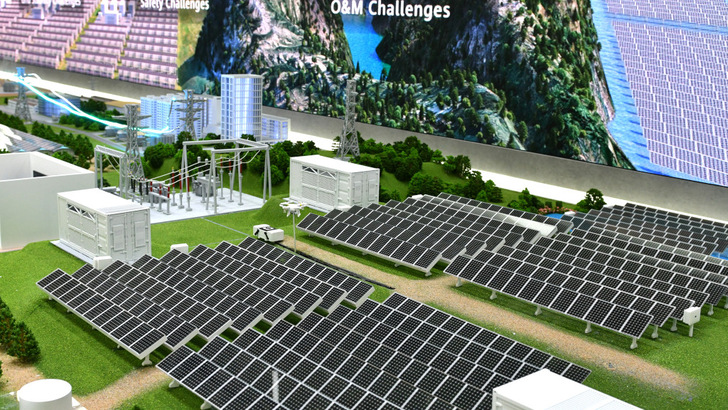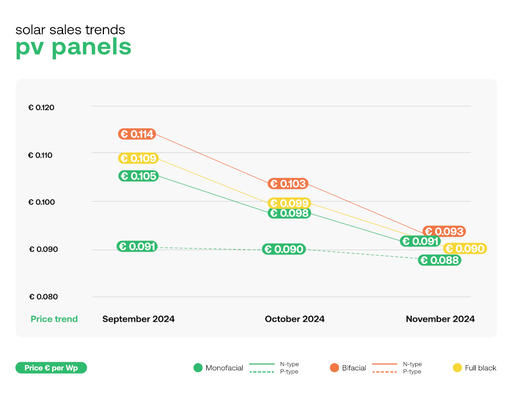The smarter E Europe’s trend paper highlights the extensive use of algorithms across the solar industry, from cell production and plant monitoring to energy management system control and inverter operation. These algorithms can process large volumes of data, driving automation, improving efficiency and optimising processes based on precise analyses.
In PV production, AI plays a key role in improving efficiency, sustainability, and durability by assisting with machine-based material analysis. It evaluates data on the physical, chemical, and structural properties of materials, enabling the discovery of innovative material combinations. Additionally, AI helps in designing more efficient solar cells. It also supports data-driven analysis of production facilities, detecting when systems produce faulty or inefficient products and identifying when defects arise.
From manufacturing to grid management
One of the pioneers in AI-supported digitalisation and automation of solar production is the Chinese global market leader Longi, which produces highly efficient, latest-generation back contact modules with HPBC 2.0 (Hybrid Passivated Back Contact) technology in a specially equipped factory in Jiaxing. In December 2023, the factory was recognised by the World Economic Forum (WEF) as the first ”Global Lighthouse Factory” in the solar sector.
Longi upgrades Lighthouse factory for HPBC 2.0
Many grid operators are now relying on AI to efficiently balance generation and load forecasts and to optimally control and plan their grids in light of the energy transition, as was underlined by the ”Power Grids of the Future” conference in Berlin at the end of January. AI evaluates historical weather data to better predict the volatile generation of solar and wind power, allowing energy flows to be better monitored and controlled in real time.
More efficient energy trading and monitoring
Cologne-based RheinEnergie also uses AI to operate solar parks more economically in combination with battery storage systems. AI helps to automatically match generation forecasts with electricity price forecasts to the nearest quarter hour for each day of the coming week. “Electricity marketing is our daily business,” says Dirk Franken, Head of Control and Modelling at RheinEnergie Trading (RET.). “But optimal marketing from a battery storage facility is new territory for us. It requires a very precise knowledge of the electricity market. You have to know when to store electricity and when to market it from storage.”
The smarter E Europe looks to flexibilisation, digitalisation and sector coupling
AI is widely used in the planning of large solar power plants, often through design software or geo-AI. Geo-AI involves the machine-assisted evaluation of aerial and satellite images, helping planners identify suitable sites for installations. Additionally, it can automatically generate 3D images of the planned plant, which is useful in the area of sales.
Improvements in the area of O&M
AI can also make an important contribution to the maintenance, servicing and monitoring of solar power plants. In the field of predictive maintenance, AI evaluates drone images of solar power plants and examines them for malfunctions, such as dirt on the modules. This allows necessary maintenance work to be identified before it affects the performance of the plant.
AI can also carry out important tasks in plant monitoring that were previously very time-consuming and had to be performed manually by O&M (operation and maintenance) specialists. The algorithm compares very large amounts of data and examines them for the smallest changes that could impair the function of a plant. This allows O&M personnel to concentrate on the essential tasks of monitoring operations. “Ten years ago, monitoring large solar power plants was still a nightmare,” said Susannah Wood, Vice President of Public Affairs and Sustainability at Statkraft, at a panel discussion at the SolarPower Summit in Brussels at the end of March. The use of AI has proven very successful, and the company now employs seven data specialists for the solar sector alone.
Generative AI – 85 percent automation
David Moser, Managing Director of the Italian Bequerel Institute, sees generative AI technologies as a game changer for the solar industry. These are systems that not only analyse existing data, but can also create new content, designs or solutions. “These technologies enable fundamentally different approaches to automation that go beyond rule-based systems or traditional machine learning,” says Moser.
The expert expects the degree of automation along the solar value chain to be at least around 60 percent and to reach 85 percent in the O&M phase. Through the use of generative AI and robotics, he sees cost reductions in the O&M of solar parks of €3,000-4,000/MW/year from 2030 onwards, and an 85-90% reduction in the workforce required from the current 0.5-0.7 per MW to 0.05-0.1 per MW. The increase in performance is estimated at 3-4%. However, Moser urges the industry to invest urgently in further training for existing employees due to the significant impact on the workforce. Moreover, Moser sees further challenges in the ongoing digital upgrade of the plant fleet, cyber security, the recruitment of skilled workers, and the high electricity demands of data centres. (hcn)









